Soft and buttery, you can have these raspberry scones ready in under an hour. They are slightly sweet with a tangy burst from the juicy raspberries and can be frozen for a month. All my tips for making the best scones are found in this post.

A cross between a coffee cake muffin and a biscuit, we love these floury berry triangles as an afternoon snack, for tea time, breakfast or a brunch table.
Scone recipes are favorites around here, and we love adding new ones. Raspberries add tanginess and freshness, making a simple cream scone a wonderful treat.
If you follow the tips below (also on the recipe card), you'll master the scone-making process and be able to whip them up whenever the craving hits.

Tips for making scones
Scones have simple everyday ingredients, but a few pointers should be followed if you want soft, tender ones that rise nicely.
- Very cold ingredients. I measure but leave the ingredients in the fridge until it's time to use them. Don't take the cream for half an hour before mixing the scones. Butter, milk cream and other wet ingredients belong in the fridge until you need to scatter and pour them.
- Handle the dough lightly. Don't overwork the dough. It needs to remain cold so the butter doesn't start to melt. It's the way to get soft, tender scones that rise well.
- Very cold dough before baking. Pop them in the freezer for 15 minutes after shaping them and before baking them. That ensures that they bake and rise as much as they can.
- A rather high oven. They need that extra heat to rise however they can despite all that butter and cream. And if you forgot to turn the oven on before you start mixing, please don't leave the baking sheet with the cut scones waiting on the counter. Put them in the fridge or freezer for the ten or fifteen minutes it takes for the oven to reach its temperature.
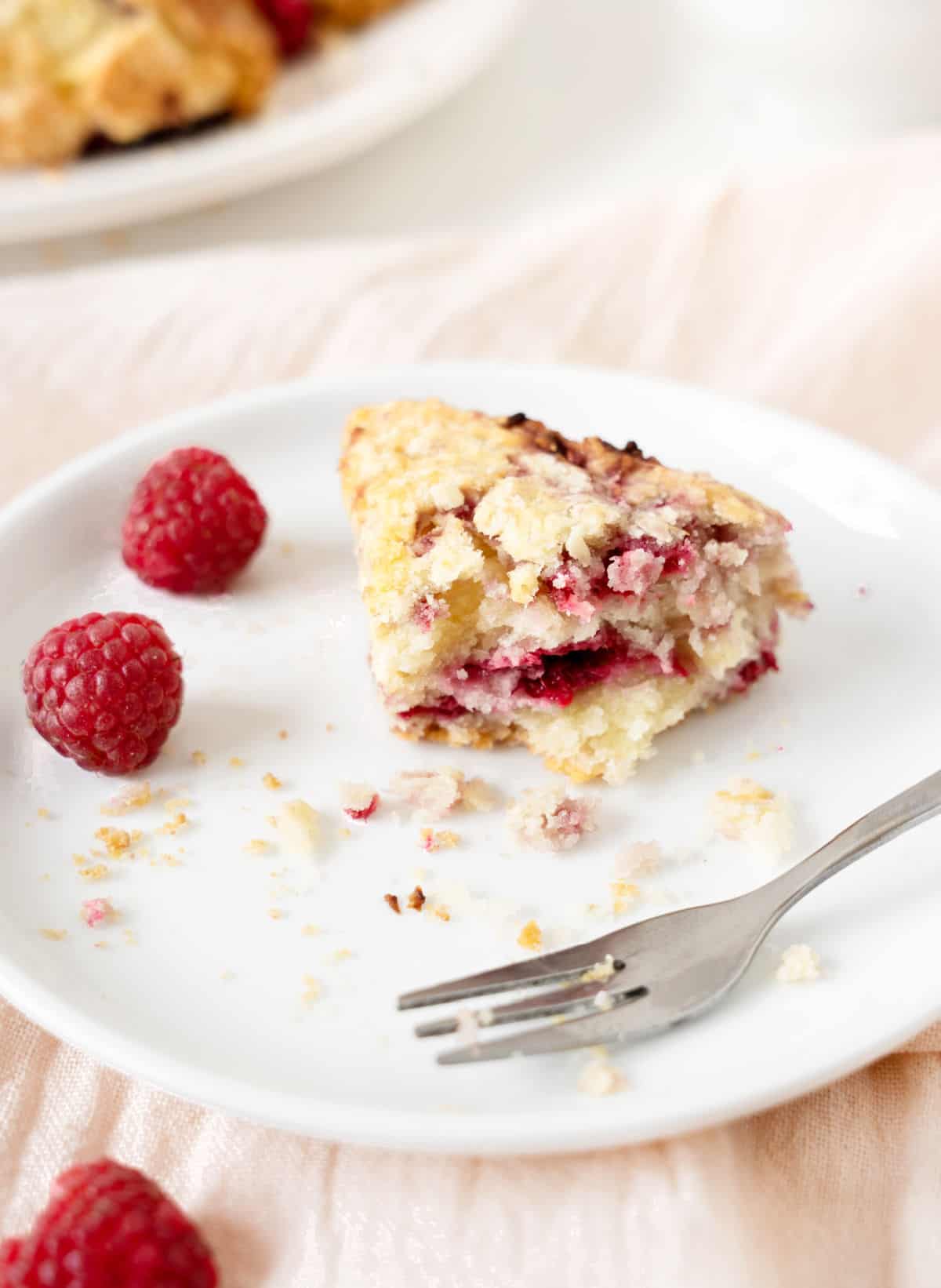
Ingredient list
- Raspberries: fresh or frozen (unthawed).
- Buttermilk: if you don't have buttermilk, you can buy buttermilk powder and prepare it as needed. Or make homemade buttermilk (it's VERY easy; see Notes in the recipe card for details).
- Cream: whipping, heavy whipping or heavy cream work for this recipe.
- Unsalted butter.
- White granulated sugar.
- All-purpose flour.
- Baking powder: make sure it's not expired.
- Salt: I like using kosher salt or fine sea salt when baking. But regular table salt works just fine.
- Lemon zest: it's optional, but lemon raspberry scones are a great flavor combination.
See the recipe card towards the end of this post for quantities.

Variations & substitutions
- Yogurt: substitute the buttermilk and cream for natural Greek yogurt, same volume (cups and tablespoons).
- Vanilla extract: use ½ a teaspoon in addition to or instead of the lemon zest for a mellower flavor.
- Spices: add some ground cinnamon or cardamom.
- Glaze: top the room temperature scones with a citrus powdered sugar glaze, using orange or lemon juice as the liquid.
- White chocolate raspberry scones: add white chips or chunks to the dough or a white chocolate ganache glaze after baking.
- Raspberry almond scones: add ¼ cup coarsely chopped or sliced almonds and about ¾ teaspoon of pure almond extract and ¼ teaspoon of vanilla to the dough instead of the lemon zest.
How to make raspberry scones
You mustn't overwork the scone dough. The butter should remain as cold as possible, and the gluten in the flour should not develop. It's how to get the scones to rise well and be tender, not flat and tough.
That's why we refrigerate or freeze the formed scones before baking.

Working surface: the dough will have dry patches, so don't flour it from the beginning.
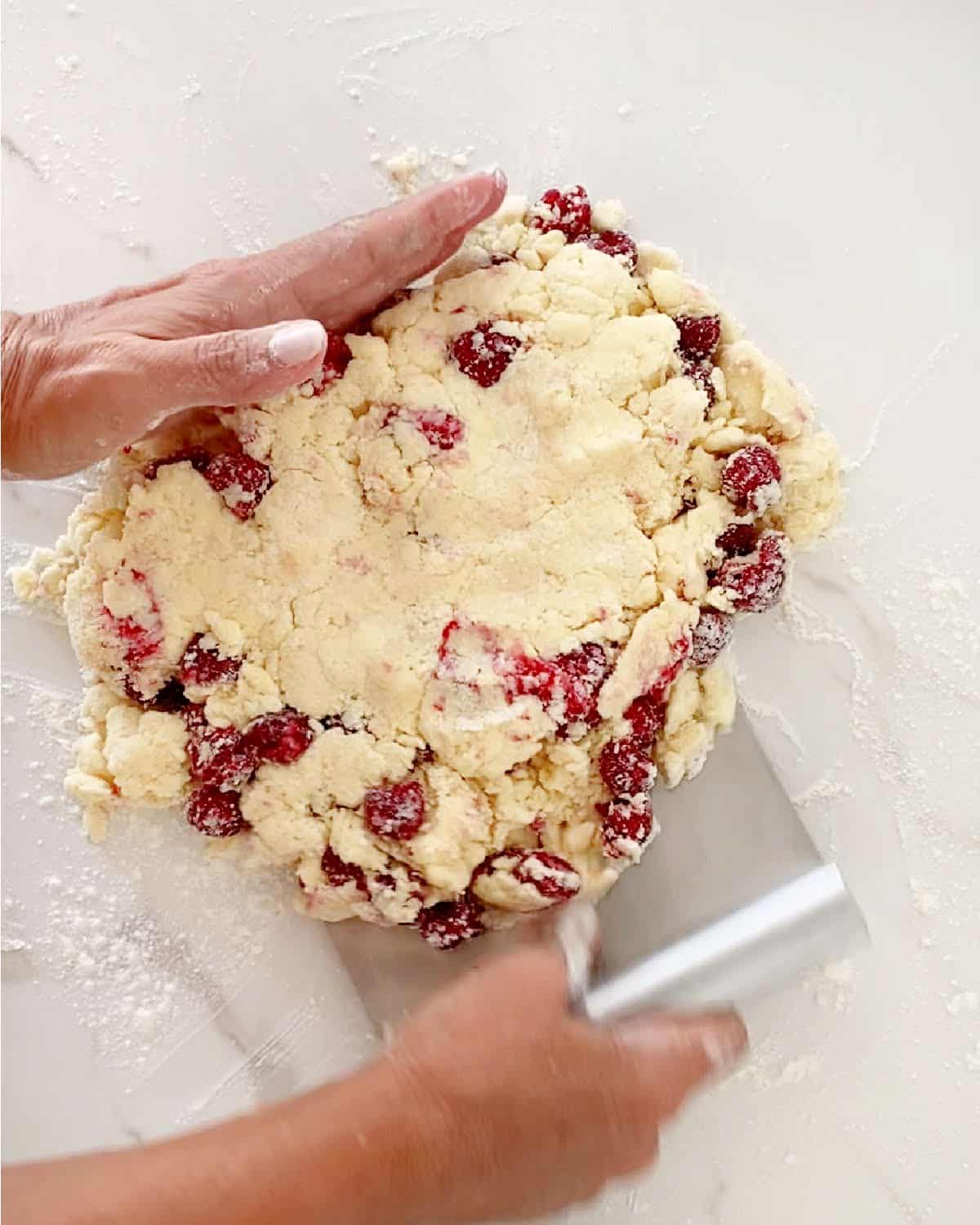
Dough scraper: it's a great little tool to help you fold the shaggy mass onto itself so it slowly comes together. With each fold, it will be more formed. Pat the dough into a circle, but do not overwork it! You can also use a metal spatula to help you with the dough.
Cutting and baking
- Shape: I like triangles for fruit scones, but you can use a round cutter like we do for the buttermilk scones.
- Size: eight triangles is the perfect amount. It might seem like the scones are relatively small, but they will expand and grow during baking. Cut 6 pieces if you want very large scones.
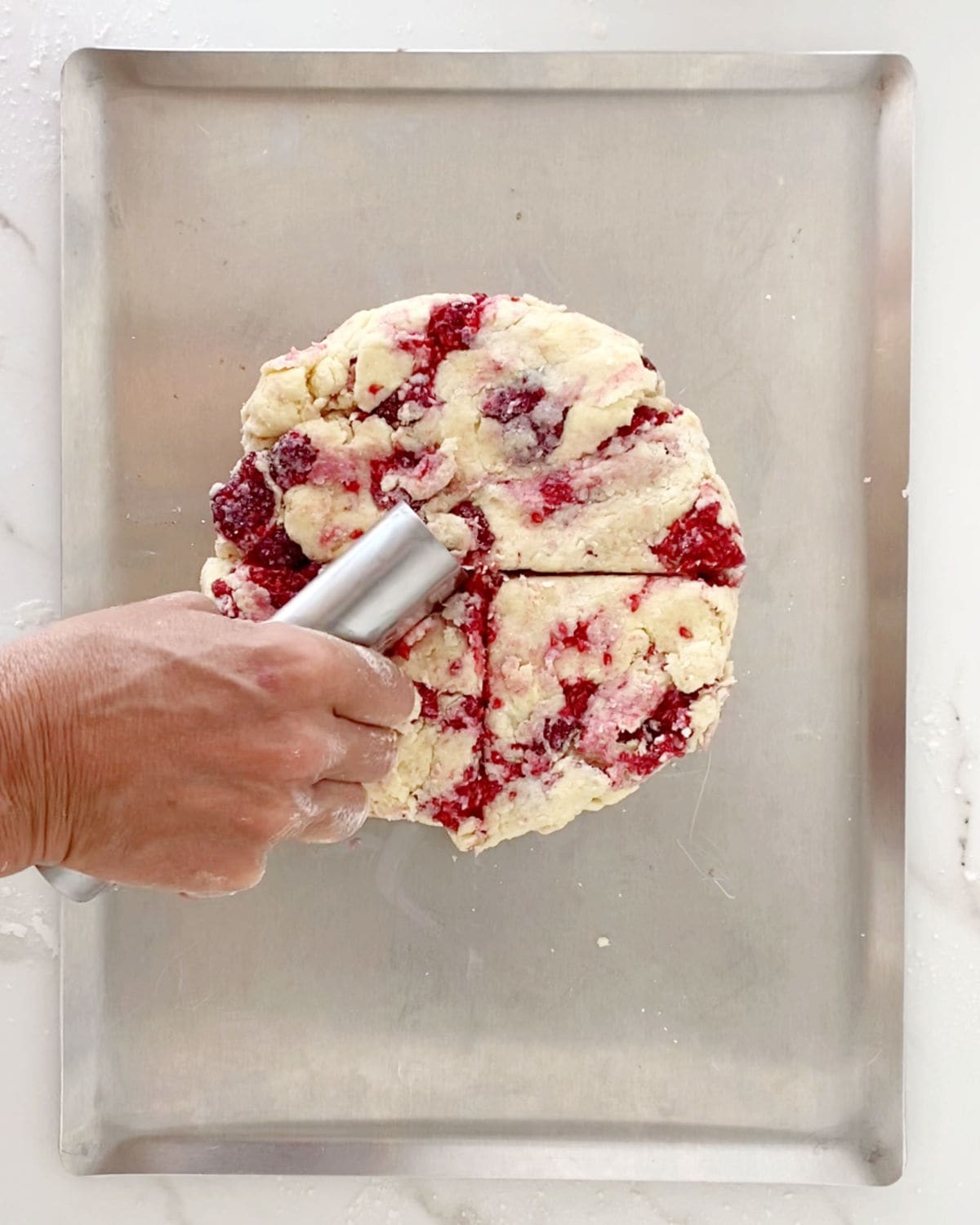
Cutting the disc of dough: I cut it into 8 triangles with the dough scraper or a large kitchen knife. But you can use a round cookie cutter.

Separate the triangles: this is necessary so the scones have space to expand during baking.
Vintage Kitchen tip: sprinkle a little sugar (white or light brown) on top of the scones before baking for a crunchier top.
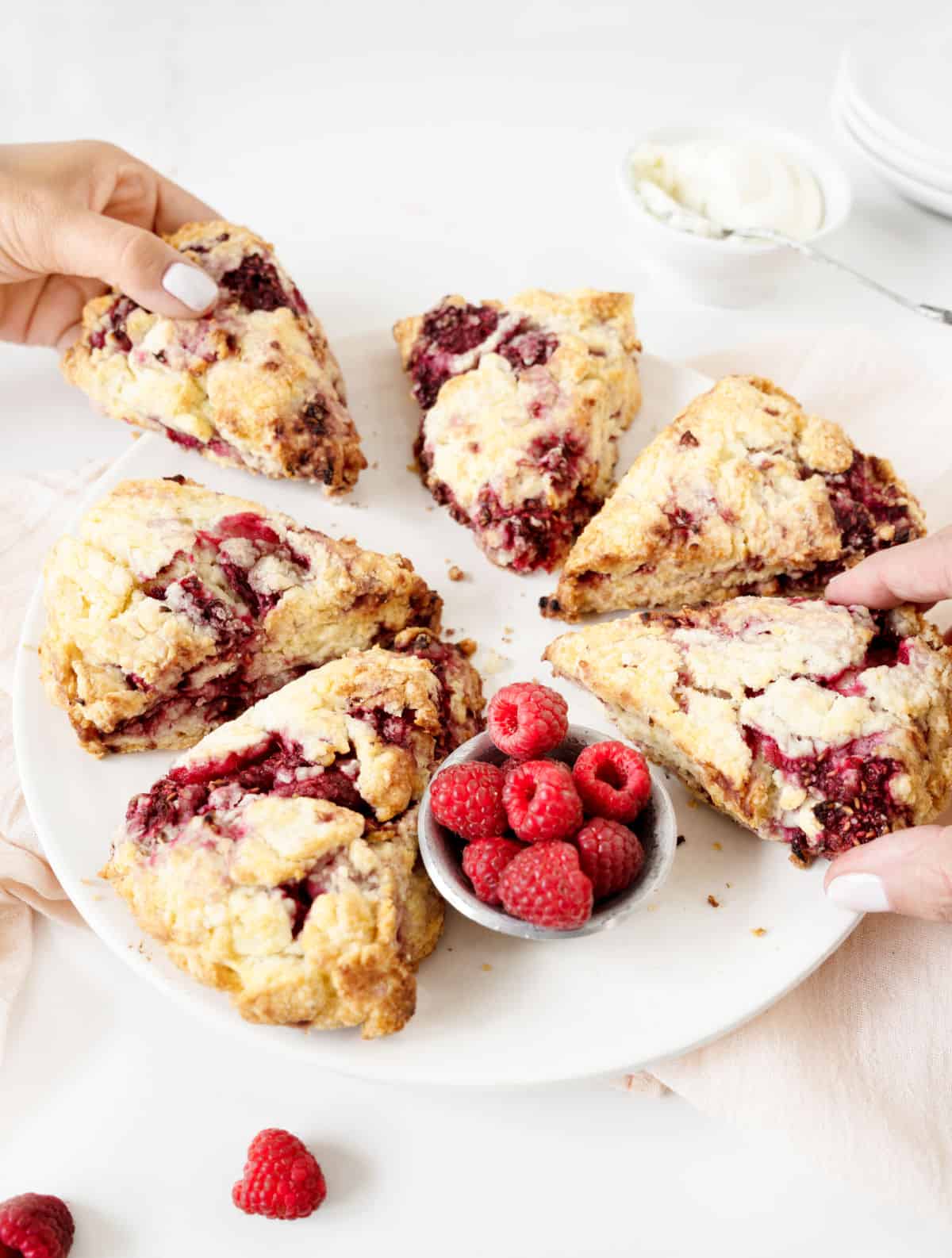
Freezing scones
Scones freeze like a dream. You can keep a batch in the freezer and bake to order!
- You can freeze them at room temperature or barely warm. The latter tends to hold moisture better, but that can be debatable.
- Freeze the already cut scones on the baking sheet until they are rock solid, and then transfer them to a freezer bag or airtight bag Ziploc-style. That way, they will be covered and occupy much less space in your freezer.
- Bake them directly from the freezer in a 375°F/190°C oven for ten minutes. Turn down the oven to 350°F/180°C and continue baking until fully done. They might take a few more minutes.

Kitchen notes
- Organization: read the recipe first and ensure you have ingredients at the correct temperature, equipment, and enough workspace. This will make the process so much easier.
- Baking time: consider that all ovens and pans are different, even if they look similar. The baking time in my recipes is as accurate as it can be, but it might take you more or less time. You can use a thermometer(like the OXO oven thermometer) to check that your oven is at the right temperature. I recommend you keep track of how your oven works and what tiny details you might need to adjust.
- Different sizes: for a brunch table, tea time, or that type of gathering, you might want to make smaller scones, and round ones at that (check out the parmesan chive scones as a guide to the shape) as they are usually easier to handle and bake more evenly. Use a round cookie cutter.
- Serving scones: eat them warm or at room temperature, preferably within a few hours of baking. Serve them plain, with a dollop of whipped cream or a drizzle of lemon glaze. Each variation is a different experience, so try them out and find your favorite.
Related recipes you might like:
Let me know in the comments below if you made this recipe and loved it and if you had issues so we can troubleshoot together. I love to hear what you think, always. Thanks for being here. It's much appreciated.
You might also consider subscribing to our FREE Baking the Best email series and our regular newsletter. Or connect via Facebook, Instagram, and Pinterest.
As an Amazon Associate, I earn from qualifying purchases. Please read my disclosure policy.
Print
Raspberry Scones
Soft and buttery, this raspberry scone recipe is ready in under an hour. They have a tangy burst from the sweet raspberries, and the formed scones can be frozen for a month so you can bake them to order. They're excellent for afternoon tea, as a snack and for a brunch table.
- Total Time: 50 minutes
- Yield: 8 scones
Ingredients
- 2 ¾ cups all-purpose or pastry flour
- 1 tablespoon baking powder
- ¼ teaspoon salt
- 7 tablespoons granulated white sugar
- ½ teaspoon lemon zest
- 6 oz unsalted butter, cut into cubes, very cold
- ½ cup buttermilk, very cold
- ¼ cup cream, very cold
- Extra sugar, for sprinkling
- 1 ½ cups raspberries, fresh or frozen (directly from the freezer)
Instructions
- Preheat oven to 400ºF /200ºC.
- Line a baking or cookie sheet with parchment paper or grease the bottom.
- Food processor: place flour, baking powder, salt, sugar, and orange zest in the bowl of a food processor fitted with the steel blade. Pulse a few times to mix.
- Scatter the cold butter cubes on top, and process on low until the mixture is grainy and the butter the size of peas. Don't overprocess.
- By hand: add the dry ingredients to a large bowl and combine them well with a spoon or rubber spatula.
- Scatter the cold butter pieces on top and integrate by hand or with a pastry cutter or pastry blender. The pieces of butter should be the size of peas and beans. It will be irregular. Then, follow the recipe below.
- For both methods: transfer the mixture to a large mixing bowl and add the berries. If using frozen raspberries, don't thaw them. Mix lightly with a spoon or rubber spatula.
- Drizzle the buttermilk and cream over the flour mixture.
- Mix with a fork until it barely comes together, but don't mix too much, or the scones will be tough and flat.
- On a lightly floured surface, transfer the mixture and pat it together, folding it unto itself a few times (I use a dough scraper or dough cutter to help me fold the dough onto itself) until you have a circle of dough that holds together. It will still be shaggy in places. Don't be tempted to overwork it as you would a pie crust. I don't use a rolling pin, but if you want to, roll it very lightly, you don't want to press it down, simply pat it so it holds together.
- Make a circle with the dough, about 2 inches high.
- Cut it in half, and then cut each half into 4 triangles. You should have 8 pieces or triangles.
- At this point, they can be frozen, well covered, for up to a month, and baked directly from the freezer. They might take a few more minutes.
- Transfer to the prepared baking sheet, and sprinkle the tops with additional sugar.
- Bake for 15 minutes, turn down the oven temperature to 350°F/180°C, and bake for an additional 20-25 minutes, until golden brown, dry, and quite firm. If you need to check, with the tip of a fork lift the top of a scone and see if the inside is dry. Depending on the size and height, the bake time might vary, so start checking at the 30-minute mark.
- I recommend eating them within a few hours of being baked.
- Store leftovers in an airtight container for a day, maybe two, but the texture is much better the day they're baked.
Notes
- Organization: read the recipe first and ensure you have ingredients at the correct temperature, equipment, and enough workspace. This will make the process so much easier.
- Baking time: consider that all ovens and pans are different, even if they look similar. The baking time in my recipes is as accurate as it can be, but it might take you more or less time. You can use a thermometer(like the OXO oven thermometer) to check that your oven is at the right temperature. I recommend you keep track of how your oven works and what tiny details you might need to adjust.
- Very cold ingredients. I measure but leave the ingredients in the fridge until it's time to use them. Don't take the cream for half an hour before mixing the scones. Butter, milk cream and other wet ingredients belong in the fridge until you need to scatter and pour them.
- Handle the dough lightly. Don't overwork the dough. It needs to remain cold so the butter doesn't start to melt. It's the way to get soft, tender scones that rise well.
- Very cold dough before baking. Pop them in the freezer for 15 minutes after shaping them and before baking them. That ensures that they bake and rise as much as they can.
- A rather high oven. They need that extra heat to rise however they can despite all that butter and cream. And if you forgot to turn the oven on before you start mixing, please don't leave the baking sheet with the cut scones waiting on the counter. Put them in the fridge or freezer for the ten or fifteen minutes it takes for the oven to reach its temperature.
- Different sizes: for a brunch table, tea time, or that type of gathering, you might want to make smaller scones, and round ones at that (check out the parmesan chive scones as a guide to the shape) as they are usually easier to handle and bake more evenly. Use a round cookie cutter.
- Serving scones: eat them warm or at room temperature, preferably within a few hours of baking. Serve them plain, with a dollop of whipped cream or a drizzle of lemon glaze. Each variation is a different experience, so try them out and find your favorite.
- Prep Time: 15 minutes
- Freezing time: 10 minutes
- Cook Time: 25 minutes
- Category: Scones & Biscuits
- Method: Baking
- Cuisine: International
Nutrition
- Serving Size: ⅛
- Calories: 381
- Sugar: 11.4 g
- Sodium: 41.6 mg
- Fat: 19.7 g
- Carbohydrates: 46.7 g
- Fiber: 2.7 g
- Protein: 5.5 g
- Cholesterol: 51.6 mg



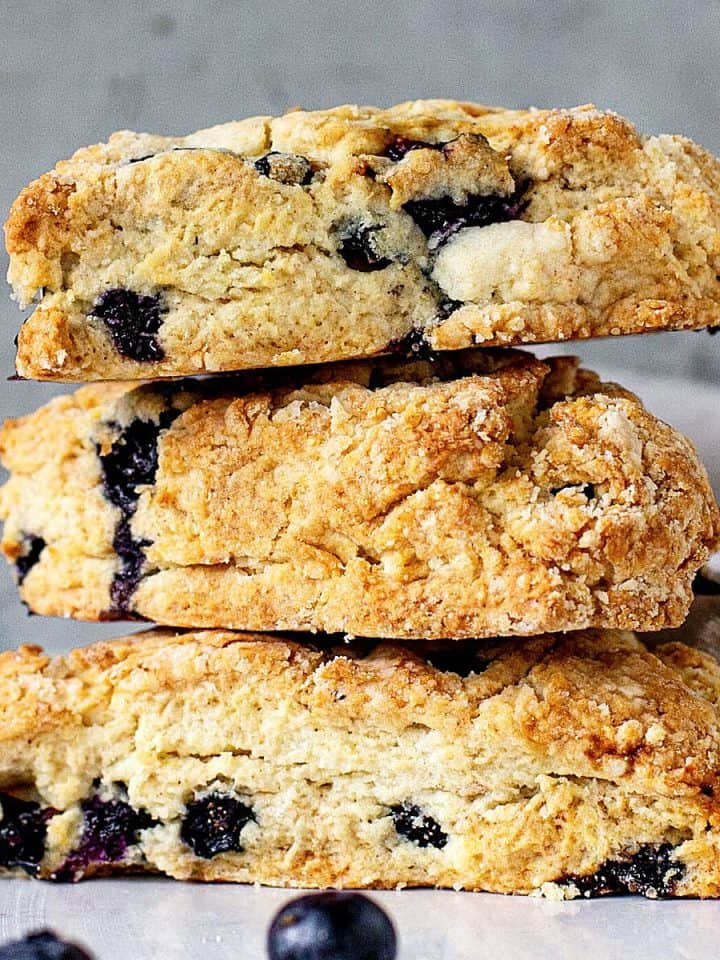



Steven King says
I was fortunate to find this recipe when fresh raspberries were available. My scones looked very much like the ones pictured and were delicious. I didn't have lemon zest but did use real buttermilk and 18% cream. Simple but tasty.